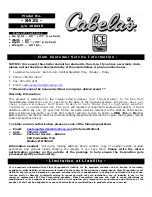
32
If the Buzzer setting is off (indicating that the buzzer is
disabled for all of the alarms), this symbol will be open.
Shallow alarm set
You can set an alarm to go off if the boat moves into water
which is shallower than a certain depth. If you set this type
of alarm, the “S” indicator will appear on the display. If the
alarm is triggered, the “S” symbol will flash. If the buzzer
has been turned on (in the System Setup display), the
buzzer will also sound. To stop the buzzer, press the
CLEAR
button. The “S” symbol will continue to flash until you move
into deeper water.
Deep alarm set
You can set a different alarm to go off if the boat moves into
water which is deeper than a certain depth. When this
alarm is set, the “D” symbol will appear. If the alarm is
triggered, the “D” symbol will flash. If the buzzer has been
turned on (in the System Setup display), the buzzer will
also sound. To stop the buzzer, press the
CLEAR
button. The
“D” symbol will continue to flash until you move into
shallower water.
Fish alarm set
The FishFinder also has an alarm which will sound when-
ever it detects a fish. When this alarm is set, the fish
symbol appears at the bottom of the display. If the alarm is
triggered and the buzzer has
been
turned
on
(in
the
System
Setup display), the buzzer will sound for a moment.
Before we explain the other pages, there are some general things you
should know about the operation of the FishFinder.
Choosing a Frequency
We said that the FishFinder uses sound waves to “see” through the water
under the boat. The “frequency” is a measure of how fast the sound
waves change or “vibrate.” The FishFinder uses sound waves with two
different frequencies – 50 kHz and 200 kHz. Raymarine uses these two
frequencies because each is better for a particular purpose.
Operating Instructions

































